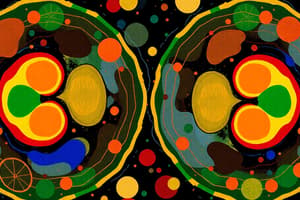Podcast
Questions and Answers
Which of the following is the correct chronological order of phases in mitosis?
Which of the following is the correct chronological order of phases in mitosis?
- Prophase, Telophase, Metaphase, Anaphase
- Anaphase, Telophase, Prophase, Metaphase
- Prophase, Metaphase, Anaphase, Telophase (correct)
- Metaphase, Anaphase, Telophase, Prophase
During which phase of mitosis do the sister chromatids separate and move towards opposite poles of the cell?
During which phase of mitosis do the sister chromatids separate and move towards opposite poles of the cell?
- Prophase
- Telophase
- Metaphase
- Anaphase (correct)
What is the primary event that occurs during the metaphase stage of mitosis?
What is the primary event that occurs during the metaphase stage of mitosis?
- The cell divides into two daughter cells.
- Chromosomes align at the center of the cell. (correct)
- Sister chromatids condense.
- The nuclear envelope breaks down.
In which phase of mitosis does the nuclear envelope reform, and the chromosomes decondense?
In which phase of mitosis does the nuclear envelope reform, and the chromosomes decondense?
Which of the following is a function of mitosis?
Which of the following is a function of mitosis?
Flashcards
Mitosis
Mitosis
The process of cell division that results in two daughter cells genetically identical to the parent cell.
Interphase
Interphase
The stage in the cell cycle when the cell grows, copies its DNA, and prepares for division.
Prophase
Prophase
The first stage of mitosis, where the chromosomes condense and become visible.
Metaphase
Metaphase
Signup and view all the flashcards
Cytokinesis
Cytokinesis
Signup and view all the flashcards
Study Notes
Cell Division
- Cell division is the process by which a parent cell divides into two or more daughter cells.
- Learning outcomes for the lesson include identifying stages of mitosis and meiosis, describing the stages of mitosis and meiosis, and differentiating between mitosis and meiosis.
- The eukaryotic cell cycle has two major phases: interphase and mitosis.
Cell Cycle
- Interphase is the non-dividing state and includes three sub-stages: G1, S, and G2.
- G1: Cell growth, organelles are replicated.
- S: Replication of DNA and synthesis of proteins associated with DNA.
- G2: Synthesis of proteins associated with mitosis.
- Mitosis is the division phase, with four stages: prophase, metaphase, anaphase, and telophase.
- Mitosis is followed by cytokinesis, dividing the cytoplasm into two new cells.
- Like prokaryotic cells, eukaryotic cells grow, replicate DNA, and undergo cell division. The timing of replication and cell division is highly regulated.
Mitosis
- Mitosis is the process of division of somatic cells (non-reproductive cells).
- A single cell divides into two identical daughter cells.
- Daughter cells have the same number of chromosomes as the parent cell.
Packing for the Move
- When cells are not dividing, their DNA exists as chromatin (an extended, uncondensed form).
- DNA replication and transcription can only happen when DNA is in this form.
- When a cell prepares to divide, DNA condenses to form chromosomes.
- Chromosomes are single DNA molecules, making them easier to sort and arrange into daughter cells.
Mitosis Phases
- Prophase: Chromosomes condense, spindle fibers form, and chromosomes are captured by spindle.
- Metaphase: Chromosomes align along the cell equator with one kinetochore facing each pole.
- Anaphase: Sister chromatids separate, spindle fibers shorten, chromatids are pulled towards poles, and free spindle fibers lengthen pushing the cell poles apart.
- Telophase: Spindle fibers disintegrate, nuclear envelopes form around both sets of chromosomes, chromosomes revert to their extended state, and cytokinesis occurs, creating separate daughter cells.
Cytokinesis: Plant vs. Animal
- Plant cells undergo cytokinesis by forming a cell plate between the two daughter nuclei.
- Animal cells undergo cytokinesis by forming a cleavage furrow where microtubules contract, pinching the cell in half.
Germ Cells vs. Somatic Cells
- Germ cells are involved in sexual reproduction.
- Somatic cells are all the other cells in the body, involved in normal cell functions
Meiosis
- Meiosis is the process of germ cell division, which produces four unique daughter cells.
- Daughter cells have half the number of chromosomes as the parent cell.
Ploidy
- Ploidy refers to the number of chromosome sets in a cell.
- Haploid cells: Designated as "n," having one copy of each chromosome.
- Diploid cells: Designated as "2n," having two sets of chromosomes.
- Diploid organisms receive one chromosome of each type from the female parent and one from the male parent.
Homologous
- Chromosomes exist in homologous pairs in diploid cells (except sex chromosomes, X and Y).
- Other chromosomes are called autosomes, and also have homologues.
Meiosis I
- Prophase I: Chromosomes condense, nuclear envelope breaks down, crossing over occurs.
- Metaphase I: Homologous chromosomes move to the cell's equator.
- Anaphase I: Homologous chromosomes move to opposite poles of the cell.
- Telophase I and Cytokinesis: Chromosomes gather at the poles, cytoplasm divides.
Crossing Over
- Homologous chromosomes break at identical locations and then rejoin, creating new combinations of alleles on each chromosome.
- Crossing over happens randomly several times on each chromosome.
Meiosis II
- Prophase II: A new spindle forms around chromosomes.
- Metaphase II: Chromosomes line up at the cell's equator
- Anaphase II: Centromeres divide, and chromatids move to opposite poles of the cell.
- Telophase II and Cytokinesis: Nuclear envelopes form, cytoplasm divides, creating four haploid cells.
Mitosis vs. Meiosis (summary)
- Both processes are used in cell division. Miosis creates genetically different cells, while mitosis creates genetically identical cells.
Studying That Suits You
Use AI to generate personalized quizzes and flashcards to suit your learning preferences.





